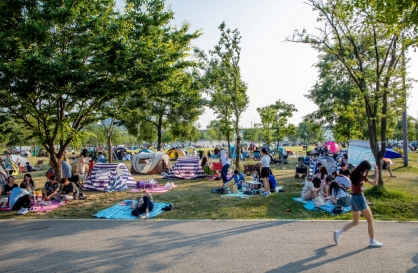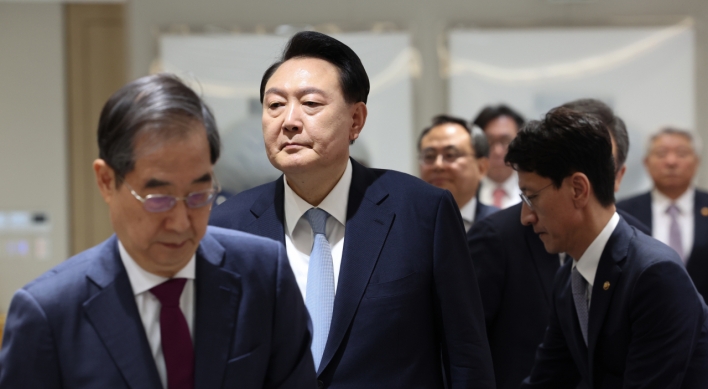COVID-19 to boost warehouse investment in Korea: CBRE
By Son Ji-hyoungPublished : Sept. 3, 2020 - 15:21

The novel coronavirus has accelerated demand for investment in South Korea’s grade-A logistics assets, beyond demand for prime offices and other safe assets, top officials from CBRE Korea said Thursday.
Logistics centers, including fulfillment centers and cold storage warehouses, have been more resilient in Korea than any other commercial real estate in the wake of the COVID-19 pandemic in the first half of 2020, Claire Choi, head of research at CBRE Korea, said in a teleconference with reporters.
The shift to logistics centers is accelerated by various structural changes, as more people buy goods and fresh groceries online thanks to e-commerce players such as Coupang, while retail giants are moving in tandem to adopt new online sales channels. The rise of single-person households in the Seoul metropolitan area also contributed to the upshot in online delivery and demand for distribution centers near Seoul.
“Real estate investors should take into account how properties could stay resilient from the pandemic,” she said.
“The coronavirus damage to hotels and retail assets is anticipated to persist, decentralized offices carry risks of higher vacancy rates and core offices still suffer uncertainties as rent cuts can be forced. But logistics centers have been flexible when dealing with the structural changes in society triggered by COVID-19.”
Choi added that the nominal rate of return for prime distribution centers here is projected to stand at 5.8 percent by 2020, higher than the 4.44 percent real return from grade-A offices.
On the other hand, the constant rise in demand for warehouses accompanies an increase in supply. The combined gross floor area of Korean logistics properties is projected to double by 2022 compared with 2019, when the figure stood at roughly 7 million square meters.
The increase in supply will come in conventional logistics hubs such as Icheon and Yongin, as well as areas closer to Seoul such as Incheon and Gimpo. Particularly by 2022, Incheon is expected to house some 2.5 million square meters of grade-A distribution centers by gross floor space, outrunning those of Icheon and Yongin, according to CBRE Research.
Moreover, retailers are diversifying sales channels by turning to online sales and using warehouses. This is also prompting them to create large-scale warehouses and streamline their distribution channels by incorporating existing small centers into larger ones.
“The role of logistics warehouses here used to be limited to storing goods. But warehouses are now evolving with the rise of e-commerce and the structural shift in the distribution business,” said Sean Choi, head of capital market at CBRE Korea. “This increases the demand to implement faster delivery service (for customers in or around Seoul) and build more warehouses in locations closer to Seoul.”
He also stressed the need for investors to act promptly to address demand from retailers.
“Some retailers cultivate a long-term relationship with property owners by securing additional funding from the property owners and promising a long-term contract with them. Some others are looking for suitable spots to serve as a bridge between international ports with domestic distribution networks. Investors will be able to give suggestions to retailers if they are aware of such retailers’ needs in advance,” he said.
According to CBRE Korea, the total commercial real estate transaction volume in Korea came to 5.8 trillion won ($4.9 billion) in the first half. Industrial assets including logistics centers accounted for some 15 percent of the total.
By Son Ji-hyoung (consnow@heraldcorp.com)
Logistics centers, including fulfillment centers and cold storage warehouses, have been more resilient in Korea than any other commercial real estate in the wake of the COVID-19 pandemic in the first half of 2020, Claire Choi, head of research at CBRE Korea, said in a teleconference with reporters.
The shift to logistics centers is accelerated by various structural changes, as more people buy goods and fresh groceries online thanks to e-commerce players such as Coupang, while retail giants are moving in tandem to adopt new online sales channels. The rise of single-person households in the Seoul metropolitan area also contributed to the upshot in online delivery and demand for distribution centers near Seoul.
“Real estate investors should take into account how properties could stay resilient from the pandemic,” she said.
“The coronavirus damage to hotels and retail assets is anticipated to persist, decentralized offices carry risks of higher vacancy rates and core offices still suffer uncertainties as rent cuts can be forced. But logistics centers have been flexible when dealing with the structural changes in society triggered by COVID-19.”
Choi added that the nominal rate of return for prime distribution centers here is projected to stand at 5.8 percent by 2020, higher than the 4.44 percent real return from grade-A offices.
On the other hand, the constant rise in demand for warehouses accompanies an increase in supply. The combined gross floor area of Korean logistics properties is projected to double by 2022 compared with 2019, when the figure stood at roughly 7 million square meters.
The increase in supply will come in conventional logistics hubs such as Icheon and Yongin, as well as areas closer to Seoul such as Incheon and Gimpo. Particularly by 2022, Incheon is expected to house some 2.5 million square meters of grade-A distribution centers by gross floor space, outrunning those of Icheon and Yongin, according to CBRE Research.
Moreover, retailers are diversifying sales channels by turning to online sales and using warehouses. This is also prompting them to create large-scale warehouses and streamline their distribution channels by incorporating existing small centers into larger ones.
“The role of logistics warehouses here used to be limited to storing goods. But warehouses are now evolving with the rise of e-commerce and the structural shift in the distribution business,” said Sean Choi, head of capital market at CBRE Korea. “This increases the demand to implement faster delivery service (for customers in or around Seoul) and build more warehouses in locations closer to Seoul.”
He also stressed the need for investors to act promptly to address demand from retailers.
“Some retailers cultivate a long-term relationship with property owners by securing additional funding from the property owners and promising a long-term contract with them. Some others are looking for suitable spots to serve as a bridge between international ports with domestic distribution networks. Investors will be able to give suggestions to retailers if they are aware of such retailers’ needs in advance,” he said.
According to CBRE Korea, the total commercial real estate transaction volume in Korea came to 5.8 trillion won ($4.9 billion) in the first half. Industrial assets including logistics centers accounted for some 15 percent of the total.
By Son Ji-hyoung (consnow@heraldcorp.com)








![[KH Explains] How should Korea adjust its trade defenses against Chinese EVs?](http://res.heraldm.com/phpwas/restmb_idxmake.php?idx=644&simg=/content/image/2024/04/15/20240415050562_0.jpg&u=20240415144419)











![[Today’s K-pop] Stray Kids to return soon: report](http://res.heraldm.com/phpwas/restmb_idxmake.php?idx=642&simg=/content/image/2024/04/16/20240416050713_0.jpg&u=)